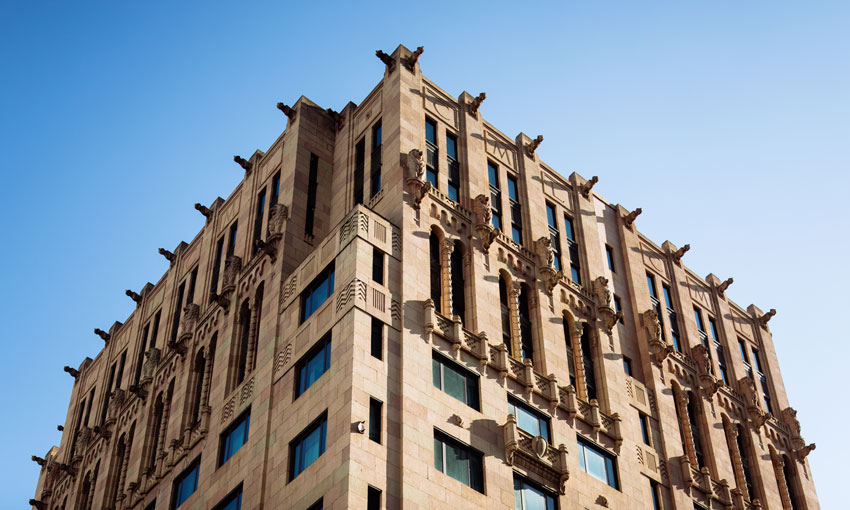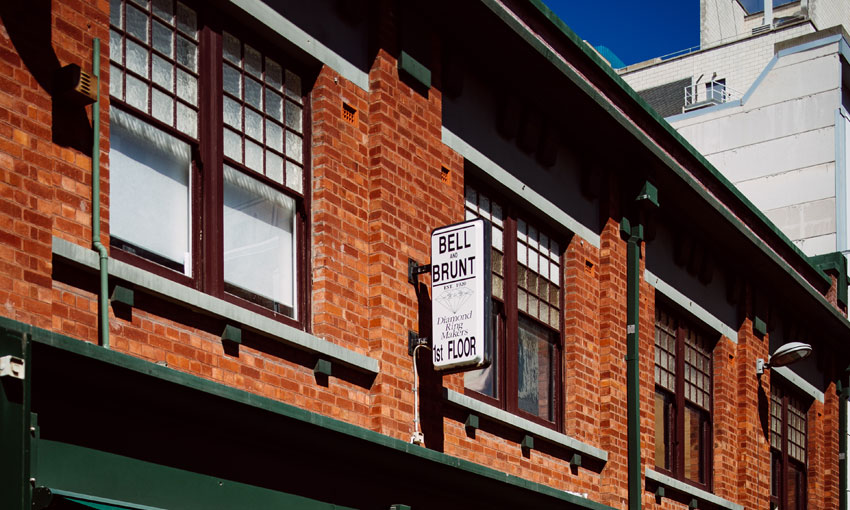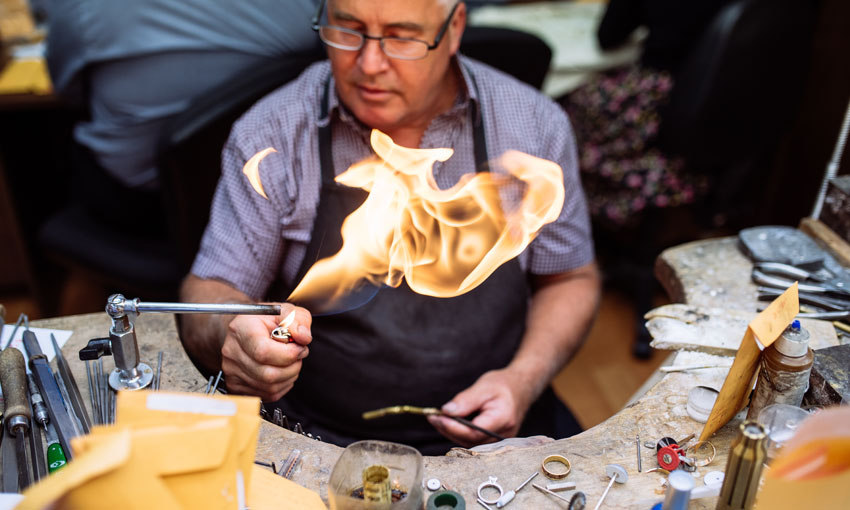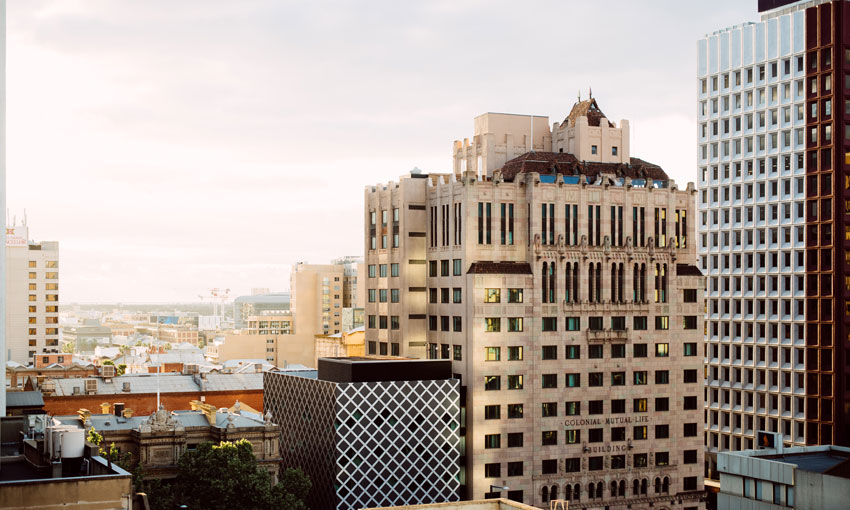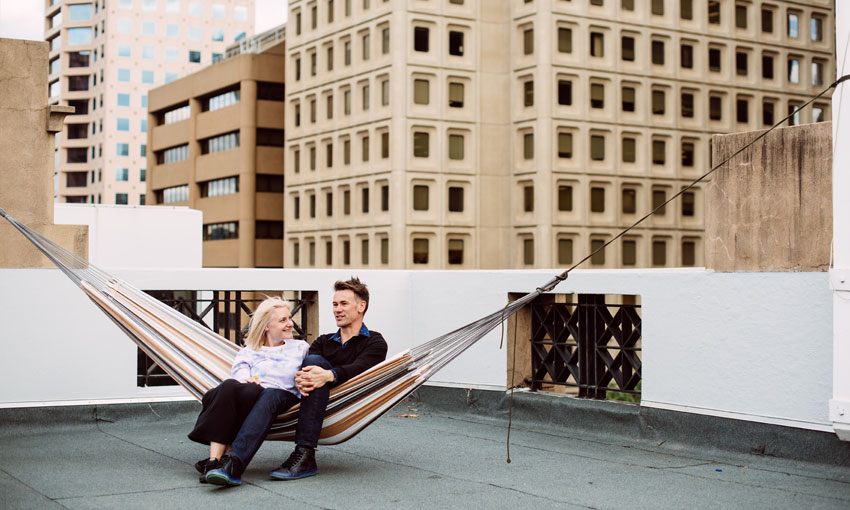A large hotel development is on the brink of completion, and a string of small businesses are thriving in the block where Rundle Mall meets King William Street. With a rash of public and private investment, this former place in-between is quickly becoming a place to be seen.
District survey: The King’s corner
Robbie Brunt started work in his family business on James Place 42 years ago. The business itself – jeweller Bell & Brunt – moved there long before that in 1925.
The hand-made diamond ring purveyor still has tenancy in the original room it leased almost 90 years ago, but has slowly expanded to take up more and more of the first floor.
Even with the decades passing, Bell & Brunt’s business hasn’t changed too much. It is the sole jeweller left in a building that used to house at least five others, and it no longer sells wholesale to shopfront jewellers – instead custom designing rings and selling them direct to punters. While the business model has changed, what the jewellers do – hand turn rings and set diamonds using a small flame at a tiny bench – hasn’t.
“Where we change, we only change where a technological change gives us a benefit in the product,” says Robbie. “It might also make it easier sometimes but the quality has to be significantly improved for us to take up a change. So we don’t get involved with castings, which is at the basis of most modern mass
production.”
Up on level one, Bell & Brunt’s day-to-day remains largely the same. But down on ground level everything has changed and keeps changing. When Robbie started working here, James Place was still open to cars and a Faulding factory sat where the Southern Cross Foodcourt is now located.
“We used to have a strip joint in the building,” adds Robbie while running through what has come and gone.
The cars and the strippers are long gone, and for a while James Place seemed to have finished its transformation – content to be a pedestrian thoroughfare between two major streets. But very recent history tracks a rapid change that has seen the laneway evolve into something more.
This end of the Mall and its offshoots carry a tremendous amount of day and night foot traffic – people walking up from the tram, train station or Adelaide Oval, those heading from offices into the shopping area, some crossing from east to west on a night out.
A few years ago, small businesses began to see the potential of an area with such an astonishing footfall volume.
Among the first wave setting up shop was Matt Lazarus and his wife Rose, who opened Fair Espresso on James Place after years running the business from a mobile coffee cart.
“That was three years ago,” says Matt. “Because we came and brought something pretty decent here, we brought a bit of a different demographic here as well. And since then things have really changed.”
Instead of just walking by, the lunchtime crowd now pause and take their time in James Place – sipping on Fair Espresso’s organic soups or munching through a salad, grabbing a bánh mì from Soonta, a pho from Mr Viet or some home-made sugo and pasta from accommodating Italian café Caparezza.
Matt says the different businesses that have sprung up attract a more diverse crowd than the old wave of office workers that used to flow through only at certain times of day.
“It’s evolved. But we actually had a target demographic and we’re getting that exact demographic coming in now,” he says. “We want the fashionable clothing store workers and the young coffee connoisseurs in Adelaide who cruise around to come west – that’s our target – but also we cater to the other workers in the area and all that. But we are hitting our demographic target perfectly.”
The westward trend is one that fits in with the city as a whole. More people visiting Adelaide Oval, the UniSA redevelopment and proliferation of charming small bars off Hindley Street have done enough to break down the stigma under which this side of town formerly laboured.

Artist Julia Townsend says she “makes an effort” to visit James Place because it is “becoming far more interesting and lively”.
But the increasing popularity of the area where King William Road, Rundle Mall, Hindley Street, James Place and Grenfell Street combine is not just a spin-off from the larger western migration. The changes are partially engineered by public investment and strategy that has, in turn, attracted private money into the area.
The Rundle Mall Management Authority’s (RMMA) Masterplan for the precinct is interpreted by many as a document that existed almost exclusively to make way for the $30 million redevelopment of the Mall. But RMMA CEO Ian Darbyshire says the plan is actually more concerned with who will use the new infrastructure than with the infrastructure itself.
“Rundle Mall will take over trying to curate how, what and where things will be coming in to the precinct,” he says. “Then, if you imagine, you can have certain things happening in the day and keep it going throughout the early evening.”
The redevelopment has seen the King William Road end of the Mall widened and equipped to become what Ian refers to as a “people’s piazza”, which is dotted – amongst the public furniture – with things like power outlets that will encourage businesses to set-up in the middle of the Mall. For this area, Ian says there are plans to attract particular businesses that will help build on an existing “distinctive character”.

The Rundle Mall refurbishment has seen the introduction of this nicely designed and resolved furniture
“What I’d like to see is maybe something quite European – somebody with a coffee machine outside or even a little bar, or for a hot day – a gelati fridge,” he says.
“We need flowers down this end of the mall – some tables and chairs, dining, flowers around you and the next thing we’re working on is trying to keep the music and entertainment going into the evening.”
The major infrastructure at this end of the Mall is very nearly completed and RMMA is calling for expressions of interest so it can evaluate how each applicant might fit into the kind of future Ian describes. As the Authority inches closer to making Ian’s vision a reality, private enterprise has been forging ahead to make the most of the precinct’s new-found vitality.
Plans for the Mayfair Hotel, which is being developed in the former Colonial Mutual Life Building at the corner of Hindley Street and King William Road, have been in the works for years, but construction is now drawing to a close.
General Manager of the hotel, Aaron Oh, says the Mayfair will benefit from the improvements in its immediate surroundings when it opens in the New Year.
“Any improvements to the city certainly won’t hurt,” he says, “they’ll improve the traffic flow and improve the quality of our public spaces.”
The owners of the Hotel – Adabco Group – have invested about $50 million in turning the abandoned 1930s building into a luxury hotel with 170 rooms, a VIP lounge, rooftop bar and a restaurant and café under the supervision of former-Urban Bistro chef Bethany Finn.
Part of the plan for the hotel is true integration with its surroundings. Rather than being shut off from the public and only providing a welcoming wave to guests, Aaron hopes the Mayfair will invite in the locals as well.
“There’s three retail outlets in the ground floor and they’re prime retail spaces. We want the right tenants in the space that will complement the hotel and at the same time provide an offering to the local Adelaideans,” he says. “We also see locals going for high tea after finishing shopping in Rundle Mall. We see people going up to the Hennesy Lounge and utitlising that space for private functions.”
Strong connection to its surroundings and a desire to keep in step with the changes in the area are also part of the motivation behind the recent renovation of the nearby Myer Centre.
“With the upgrade of our neighbours; Adelaide Oval, the popular Riverbank precinct, establishment of SAHMRI [the South Australian Health and Medical Research Institute] and the Royal Adelaide Hospital relocation, it was important to refresh into our new positioning, to meet the needs of the future customer utilising the North West Precinct of the city,” says the Myer Centre’s marketing manager Sarah-Jane Hook.
The Centre refurbishment includes significant work – upgrades of the entrances, a re-launched brand, an overhaul of the food court, façade facelifts for several floors and the addition of a giant sculptural artwork – among other things. This investment from the Myer Centre is a strong indicator of the future prospects of the area.
As this renovation concludes, the Mayfair Hotel opens, laneways like James Place attract more and more small business and the western end of the Mall fills with activity, Ian Darbyshire of the RMMA could well feel like his job in this part of town is done. But he’s setting his sights higher.
“So you look out the window and you see all these upper layers with nothing in them, so why don’t we get the upper layers happening?” he asks.
Housing is one thing not strongly represented in the area that Ian thinks could fit on those disused, above-ground floors. We’re unsure if he knows about the apartment and rooftop garden just near his office that CityMag visits later in the day, but the lives of the residents there are certainly a good test case for how future tenants might utilise the area.
Housemates Mat Kesting, Jordan Taylor and Kate Moskwa live in unusual harmony up six flights of stairs in an apartment over-looking the Mall. After four-and-a-half years, Kate has been there the longest, but all three seem to have a real affection for the area.
While Mat admits it took him a while to get used to the sound of “buses instead or birds” in the morning, both he and Kate (Jordan is at work when we visit) extol the virtues of walking to work, not owning cars, and other nearby amenities.
“If you’re particularly hungover on a Saturday you can have the ultimate food court degustation at Southern Cross,” says Kate.
“It’s just so easy to say yes to something,” adds Mat. “You just think – ‘I’ll duck out and go to that’. And you end up doing three things each night and after a few months of that I realised I was exhausted and needed to chill out a little bit.”
Mat, the exhibition manager at the Mercury Cinema, and Kate, the Program Co-ordinator at the SALA Festival, both work long hours and often finish at odd times. Occasionally bumping into each other back at home after a late night finish, they’ve watched over the precinct from their kitchen window as it’s grown and changed.
As the new money invested in the area sees the most recent wave of transformation completed, they’re bound to see an ever-thickening swell of people spending more time down below discovering the places they’ve loved for years.
Starting something
Michael Reid says he never really meant to start running a co-working community. And, by his own account, leasing a space in the old Tattersall’s Building near the corner of King William and Grenfell Street was almost a complete accident.
“People have become my thing. People and physical space and mashing them up in a way that works,” he says; waving vaguely at the place he co-founded – Majoran Distillery.
Years ago, Michael was (miserably) working as an accountant, teaching himself how to code in his spare time and dreaming of running his own start-up tech business. He met Chhai Thach who was in a similar situation.
At first the pair were working on their own start-up idea out of a small office with just a few others renting desks and working around them, but when the large Grenfell Street space Majoran now occupies became available it seemed to draw Michael in.
“This space just sort of happened to be the right price,” says Michael. “It had the big open area – it was full of left over stuff when we first came, but it had that big space and we could rip out some spots for a separate office and a reception. So it was minimal work, and it was fairly cheap.”
Since moving in here Majoran has attracted about 43 tenants – the majority of whom work in the technology start-up realm. Responsibility for running the co-working venture was taken over solely by Michael as his passion and aptitude for encouraging collaboration and a sense of community became obvious.
Many of the people CityMag chatted with for this story recommended The Coffee Pot as an excellent place for a quiet drink. From our own experience, we would also recommend dropping by Caparezza for a quick Aperol Spritz next time your day needs brightening.
“Entrepreneurship is the hot thing right now, but it’s still an oral tradition,” says Michael. “You can watch as many videos on YouTube as you like or go to as many conferences, but you learn it through osmosis and sitting down one-on-one with someone who has been through shit. So the stories that people tell – having those stories helps everyone at Majoran.”
Majoran feels unlike anything else in this area; it’s really unlike anything else in the city. And while these 40-plus people may seem incongruously located amongst the retail and food outlets of the precinct, someone in this second storey space will probably come up with an idea that will stay in our pockets on phones and devices for years, and Michael (along with lots of coffee from Please Say Please) will have made that possible.



